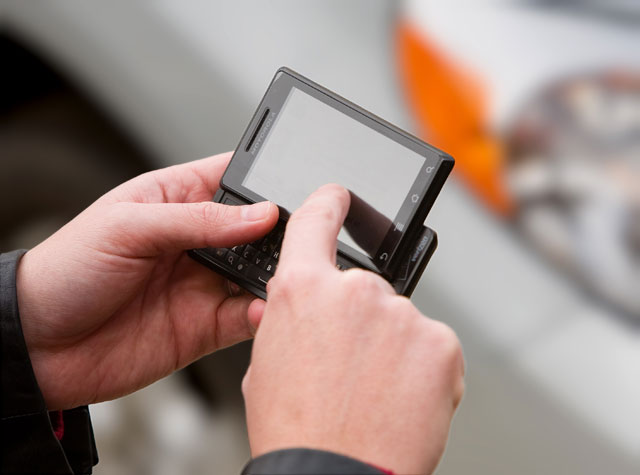Where Will Technology Take Remarketing Industry?

Technology has changed the face of the remarketing world in the last decade, providing for more avenues to remarket and bid on vehicles and allowing buyers and sellers to connect immediately, Manheim recently shared in an industry analysis.
So with all this technological progress, where is the industry going next?
According to the 2011 Manheim Used Car Market Report, it’s no secret.
“The future direction is clear: mobile functionality,” officials said in the report. “Smartphones and tablets, such as iPads, will become as important as desktop computers, if not more so, in providing buyers and sellers online access to information as well as to the auctions themselves.”
To illustrate this point, the company provided some of the statistics concerning Manheim Mobile.
Seventy-five days out from the launch of Manheim Mobile in first quarter of 2010, more than 10,000 mobile iPhone apps were downloaded.
There are twice as many Manheim Mobile website visitors now as there were during its launch. Monthly traffic is close to 133,000 visits. The company also indicated that Mobile MMR is tapped into by 13,000 users each month, with more than 9,000 users turning to the Mobile website to find vehicles.
Sharing more, the company noted that recently launched app from Manheim for the iPhone allows dealers to complete a variety of tasks from the palm of their hands. They can scan vehicles, view MMR data and tap into the company’s mobile site.
“The rollout of additional functionality and apps on devices that use other popular operating systems (such as Android) is accelerating as the variety of these devices, including new 4G phones, proliferates,” Manheim noted.
“In the near future, dealers will be able to manage their accounts and conduct business from their phones as easily as they do today from their offices,” the company continued.
Manheim’s Online Surge
Continuing along, Manheim also shared some data regarding a few of its online offerings. One of those properties, OVE.com, had a record year.
“OVE.com listed more vehicles, hosted more special sales events, and recorded more bids from unique bidders in 2010 than ever before,” officials noted.
They added that over 25,000 units are up for purchase “at any time” via Buy Now and Bid sales
More than a fifth (21 percent) of Manheim’s used-vehicle sales is done through either OVE.com or Simulcast, while a third of specialty and heavy truck and equipment sales are done through those channels.
The company said that its Manheim.com website generates weekly traffic of close to 900,000 visits.
“Market conditions in 2010 prompted a growing number of dealers (even if at first they were somewhat reluctant) to search for the vehicles they needed online as well as in the lanes,” officials shared. “As more dealers gain experience and confidence in online auctions, they develop bidding practices unique to the online marketplace.”
Changes at Physical Auctions
Continuing along, Manheim recognized that while technology has dominated much of the remarketing world’s changes, there are some basic, fundamental changes being made at the physical auction. One that Manheim pointed out was the efforts to decrease the amount of time it takes vehicles to sell.
This not only leads to cost-reduction for the customer — and possibly the auction itself — but allows new inventory to be posted sooner, Manheim indicated.
“A vehicle’s progression from entry to running in the lanes can best be thought of as a series of batched processes. Manheim’s goal is to reduce the time to sell by as much as a third by rethinking and redesigning many of the functions performed at the auctions,” officials noted.
“Because consignors can immediately place their vehicles in an online channel rather than having to wait until their next scheduled live event, this not only lowers holding costs but also generates cash faster,” they added.
During the summer, new kiosk customer registration software launched at Manheim auctions. This allowed dealers to sign in to sales and get their tasks accomplished quicker.
Dealers can use their AuctionACCESS cards to register for several sales at once, search inventory, receive messages, print reports and get gate passes.
NAAA Standards
Continuing along, Manheim also shared a bit about the National Auto Auction Association’s new standards for inspection, arbitration and certification that were launched on Jan. 1.
Perspective from auctions, dealers and consignors was considered in forming these standards, officials noted.
“Their goal was to develop rules that addressed the obstacles to dealer participation in online auctions and to improve the overall experience for buyers and sellers,” officials noted.
“Dealers, whether bidding in the lanes anywhere in the country, in Simulcast sales or in Manheim’s online marketplace, can now rely on the consistency and comparability of condition reports and in the standards behind Platinum, Gold, and Silver certifications,” they added.
Manheim also said that it and other auctions stress how important a post-sale inspection is for a buyer.
“This fast and inexpensive process quickly alerts the buyer to any undisclosed problems before incurring transportation and other costs,” the company added.
NAAA president Jay Cadigan offered his insight on the NAAA National Certification Standards
He said that through this program, “we have for the first time a consistent system for wholesale vehicle certification, regardless of consignor or auction.”
Cadigan continued: “In the past, individual auctions and consignors could have their own standards for condition reports and certification. That was confusing to the buyer. The more confidence we can give dealers that they are getting a good product, the more likely they are to buy online.”


